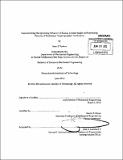Characterizing the spreading behavior of radius, contact angle, and spreading velocity of trisiloxane "superspreader" surfactants:/
Author(s)
Vaskov, Sean K. (Sean Kikeri)
DownloadFull printable version (5.177Mb)
Other Contributors
Massachusetts Institute of Technology. Dept. of Mechanical Engineering.
Advisor
Anette E. Hosoi.
Terms of use
Metadata
Show full item recordAbstract
The ability of surfactants to lower surface tension makes them a key element in many products in a variety of industries. Trisiloxane surfactants have shown extraordinary wetting on hydrophobic surfaces, and are known as "superspreaders". Studies in the past have had inconsistent results characterizing the spreading of these surfactants. In this study, the radius and contact angle during spreading of different concentrations of trisiloxane ethoxylate are measured in a humidity-controlled box. Consistent with other studies, concentrations above the critical aggregation concentration spread more, resulting in lower contact angles and larger radii. The spreading behavior for radius and contact angle can be modeled using an exponential fit. Using the exponential models, a relationship between spreading velocity and contact angle can be found. For concentrations above the critical aggregation concentration, a linear relationship between contact angle and spreading velocity was found.
Description
Thesis (S.B.)--Massachusetts Institute of Technology, Dept. of Mechanical Engineering, 2012. Cataloged from PDF version of thesis. Includes bibliographical references (p. 35).
Date issued
2012Department
Massachusetts Institute of Technology. Department of Mechanical EngineeringPublisher
Massachusetts Institute of Technology
Keywords
Mechanical Engineering.